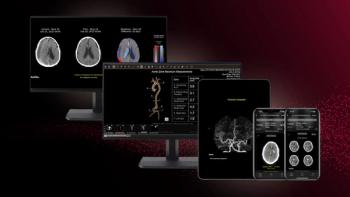
Incidental findings abound in cardiac CT imaging
There is nothing incidental about the frequency of incidental findings seen in wide field-of-view 64-slice cardiac imaging. A study by Dr. Joshua Macatol, a radiology researcher at William Beaumont Medical Center in Royal Oak, MI, found that dozens of noncoronary findings may go undetected, however, as cardiologists focus on possible coronary artery disease.
There is nothing incidental about the frequency of incidental findings seen in wide field-of-view 64-slice cardiac imaging. A study by Dr. Joshua Macatol, a radiology researcher at William Beaumont Medical Center in Royal Oak, MI, found that dozens of noncoronary findings may go undetected, however, as cardiologists focus on possible coronary artery disease.
The frequency of incidental disease does not vary significantly between symptomatic and asymptomatic patients. A retrospective review uncovered incidental findings in 46% of the 64-slice cardiac CT studies performed on 224 symptomatic patients and 42% of 19 asymptomatic patients. Overall, 37% of the studies produced at least one noncoronary finding, Macatol said.
Major findings included:
- 24 pulmonary nodules larger than 1 cm
- two pulmonary emboli
- large hiatal hernia
- bulky lymphadenopathy
Minor findings included:
- small hiatal hernia
- nonspecific lymph nodes that were less than 1 cm along their short axis
- noncalcified pulmonary nodules less than 1 cm in diameter
- emphysema
- pleural effusion
- hepatic cysts
- small pericardial effusion
- pulmonary infiltrates
- interstitial lung disease
Of the symptomatic patients, 10% had major findings and 36% had minor findings. Of the asymptomatic patients, 4% had major findings and 37% had minor findings, Macatol said.
These results bolster arguments in favor of radiologist involvement in cardiac CT interpretation, according to Dr. George Hartnell, director of cardiovascular and interventional radiology at Bay State Medical Center in Springfield, MA. It is important for radiologists to be involved because they will detect things nonradiologists will miss.
"Although the frequency of important abnormalities is relatively small, detecting them saves lives," he said.
At William Beaumont, the responsibility for reading cardiac CT is divided between cardiologists and radiologists. The cardiologist handles the coronary artery portion, then the radiology follows up, looking for other disease, Macatol said. The two groups have informally worked out a formula on how to divide fees from the readings.
When asked by Dr. David Levin, professor emeritus of radiology at Thomas Jefferson University, if he considered the arrangement equitable, Macatol answered, "No comment."
Newsletter
Stay at the forefront of radiology with the Diagnostic Imaging newsletter, delivering the latest news, clinical insights, and imaging advancements for today’s radiologists.



























